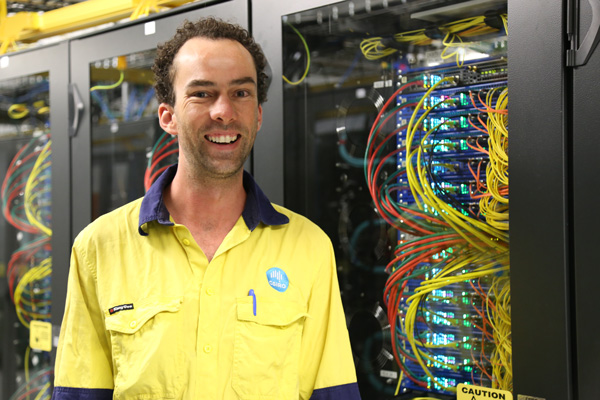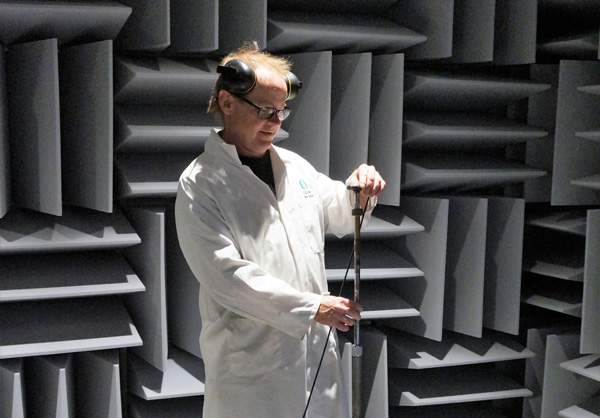We’re constantly surprised about the diversity of research here at CSIRO. This week we caught up with Alex Harding – an electrician from our Australian Square Kilometre Array Pathfinder (ASKAP) telescope – and John Watson – a testing Engineer in the Services team.
The bright spark

Alex Harding – an electrician from our Australian Square Kilometre Array Pathfinder (ASKAP) telescope.
Alex Harding, an everyday electrician from Launceston, joined CSIRO in 2011 and made the 3200km trek to Geraldton, Western Australia to become an on-site electrician at our world-class radio telescope, the Australian Square Kilometre Array Pathfinder (ASKAP).
The ASKAP telescope was built in an extremely remote location because it requires a ‘radio quiet’ area, far from mobile phones and other electronic devices that would interfere with the extremely weak natural radio signals that the telescope is designed to receive. The Murchison region of Western Australia, 800km North East of Perth, provides exactly that.
On site, Alex works as the electrical contractors licence holder and deals with all aspects of the electrical system for the telescope. Working with the installation team, he’s helped to install the first antennas and the first-generation of new radio receivers, and set up temporary power generation for the site itself. He’s also involved in regular maintenance and fault-finding.
‘Working on ASKAP is different every day, but the current priority is getting all 36 of our ASKAP antennas working together as one telescope,’ said Alex.
“You want me to move how far away?!”
– Alex Harding, on being an electrician for the Australian Square Kilometre Array Pathfinder (ASKAP) telescope.
When Alex first started in the role, he had to adjust to working extremely high off the ground.
‘The antennas are pretty tall, so we have to work out of elevated work platforms for a lot of the time,’ said Alex. ‘I am used to it now, but I don’t think anybody could ever say they enjoy working that high off the ground!’
Given Murchison’s ideal conditions for radio detection and ASKAP’s extremely sensitive receiver systems, the last thing researchers want is interference in their data from electrical and electronic devices which can be very disruptive when it comes to detecting other natural radio signals. Alex had to quickly learn on the job how to track down stray radio emissions on the site from electronic devices and develop shielding methods to remove them.
In Alex’s past life as a household electrician in Launceston, however, worrying about radio frequency interference wasn’t one of his biggest priorities. Things are entirely different working as an electrician at the Murchison Radio-astronomy Observatory.
‘Everything we design and install must be tested and checked to comply with our strict radio emissions policy.’
Sounding good

John Watson in the anechoic chamber in Clayton. Sometimes you can hear your own bodily functions (digestion) in the anechoic chamber which can become quite unnerving for some!
Prior to working with us, John Watson was an audio engineer and always had a keen interest in acoustics – the way different materials and spaces interact with sound.
He’s now one of the testing engineers that works in the reverberation chambers and anechoic chamber at our Clayton site, in Victoria.
‘A lot of audio engineers knew about electronics, instrumentation and gear, but not many people knew about acoustics – it seemed to be a bit of a black art amongst the audio engineering community,’ said John.
The reverberation rooms are mostly for construction and building material companies to make sure building code requirements are fulfilled. If you’re hearing those footsteps in the apartment above you, or the baby crying next door, it’s probably explained by those building materials not getting subjected to the rigorous testing that John carries out.
The anechoic chamber has been designed to have no reflections or reverberations from the room’s surfaces. It is used to test the ‘absolute’ volume and directional characteristics of audible emergency systems like smoke alarms and fire emergency speaker systems.
‘This type of testing looks at the directionality of the speaker, but we take other measurements too. The results allow acoustic consultants to assess how many speakers are needed to cover a given volume, for example, to ensure everyone can hear an emergency announcement.’
But in the case of an emergency – for example, a fire – you wouldn’t expect a room to have perfect acoustic conditions. So John’s team have to put speakers to the test in different physical, environmental and electrical environments.
“Deliberately put water on a speaker?
– John Watson, on being a testing engineer in Fire Systems and Acoustics.
After all, what good is a speaker in your office if it stops working as soon as there’s smoke?
The rigorous tests on speakers include ingress testing (smashing the speaker), shake testing, rain testing, corrosion testing and other heating and cooling tests.
John – upon witnessing the ‘rain’ test on the speakers for the first time – described himself as remaining in a “semi sort of panic the whole time”.
And fair enough, considering that as an audio engineer, these are the last two things you want to mix: water and an operating speaker connected to a power amplifier.
‘I’m still amazed at the level of testing that a relatively simple speaker must undergo – such as those mounted to supermarket ceilings – in order to be certified for installation.”
These speakers are supposed to be checked regularly, in preparation for the odd occasion when the speakers need to be relied on to work such as in an emergency situation.


People are at the heart of our organisation
Are you interested in a career at CSIRO?